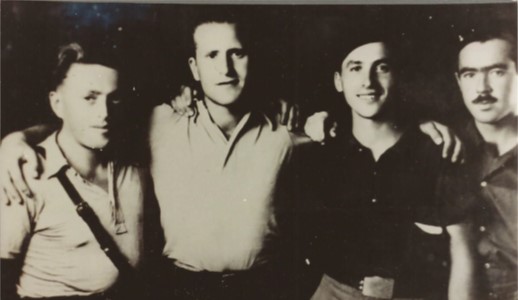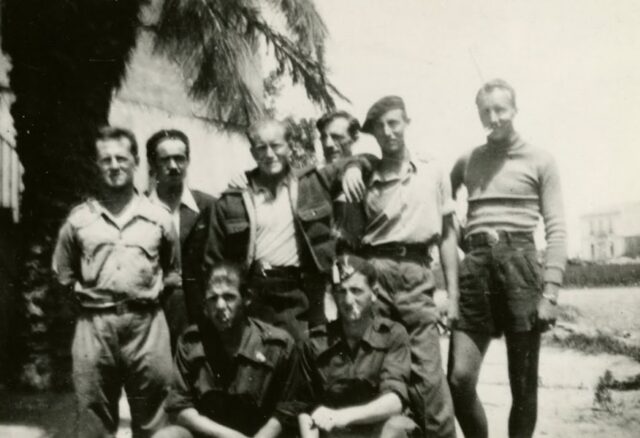
Biography
Nancarrow, Conlon Samuel b. October 27, 1912, Texarkana, Texas; mother S. C. Nancarrow; No prior military service; Attended the Cincinnati Conservatory of Music from 1930-1933 and Harvard from 1933 to 1935; Married (divorced); Music Composer; CP June 1935, cultural commission, Writers Union; Received Passport# 250312 on April 10, 1937 which listed his address as 84 Hemenway Street, Boston, Massachusetts (1920 Beach Street, Texarkansas, Arkansaw); Sailed March 10, 1937 aboard the Washington; Arrived in Spain on March 25, 1937; Served with the XV BDE, Washington BN, Co. 2, Section 1, later Company 3; Madrid Hospital #15 from July 24 to August 24; Auto Park; Defensa Contra Aviación (DECA) attached to Fuerces del Airt, International Anti-Aircraft Battery 14, the German Dimitrov Battery; Served at Jarama, Brunete, Belchite, Teruel, and Levante; WIA at Brunete; Returned to the US on February 26, 1939 aboard the President Roosevelt; Was briefly held in a French concentration camp after leaving Spain; d. August 10, 1997, Mexico City, Mexico.Sibling: brother Charles Nancarrow.
Sources: Sail; Scope of Soviet Activity; Cadre; Washington; RGASPI Fond 545, Opis 6, Delo 952, ll. 37-46; (obituary) "Conlon Nancarrow Dies at 84; Composed for the Player Piano" New York Times, August 12, 1997; website conlonnancarrow.org; Kyle Gann, The Music of Conlon Nancarrow, Cambridge University Press. Code A
Biography Conlon Nancarrow (born October 27, 1912 – August 10, 1997) was a U.S.-born composer who lived and worked in Mexico for most of his life. He became a Mexican citizen in 1955. Nancarrow is best remembered for the pieces he wrote for the player piano. He was one of the first composers to use musical instruments as mechanical machines, making them play far beyond human performance ability. He lived most of his life in relative isolation, not becoming widely known until the 1980s. Today, he is remembered as one of the most original and unusual composers of the 20th century. Nancarrow was born in Texarkana, Arkansas. He played trumpet in a jazz band in his youth, before studying music first in Cincinnati, Ohio and later in Boston, Massachusetts with Roger Sessions, Walter Piston and Nicolas Slonimsky. He met Arnold Schoenberg during that composer's brief stay in Boston in 1933. In Boston, Nancarrow joined the Communist Party. When the Spanish Civil War broke out, he traveled to Spain to join the Abraham Lincoln Brigade in fighting against Francisco Franco. Upon his return to the United States in 1939, he learned that his Brigade colleagues were having trouble getting their U.S. passports renewed because of their Communist Party membership. After spending time in New York City in 1940, Nancarrow moved to Mexico to escape the harassment visited upon former Communist Party members. Upon his first subsequent return to the U.S., in 1981 (for the New Music America festival in San Francisco), he consulted a lawyer about the possibility of returning to his native country, since the pollution in Mexico City was worsening his emphysema. He was told that he would have to sign a statement swearing that he had been "young and foolish" when he embraced communism, which he refused to do. Consequently, he continued living in Las Águilas, Mexico City, until his death at age 84. Though he had a few friends among Mexican composers, he was largely ignored by the Mexican musical establishment during most of his lifetime. Nevertheless, it was in Mexico that Nancarrow did the work he is best known for today. He had already written some music in the United States, but the extreme technical demands they made on players meant that satisfactory performances were very rare. That situation did not improve in Mexico’s musical environment, also with few musicians available who could perform his works, so the need to find an alternative way of having his pieces performed became even more pressing. Taking a suggestion from Henry Cowell's book New Musical Resources, which he bought in New York in 1939, Nancarrow found the answer in the player piano, with its ability to produce extremely complex rhythmic patterns at a speed far beyond the abilities of humans. Cowell had suggested that just as there is a scale of pitch frequencies, there might also be a scale of tempi. Nancarrow undertook to create music which would superimpose tempi in cogent pieces, and by his twenty-first composition for player piano, had begun "sliding" (increasing and decreasing) tempi within strata. (see: William Duckworth, Talking Music.) Nancarrow later said that if electronic resources had been available to him at this time, he would have probably written music for them, but they were not. Temporarily buoyed by an inheritance, Nancarrow traveled to New York City in 1947, bought a custom built, manual punching-machine to enable him to punch the piano rolls. The machine was an adaptation of one used in the commercial production of rolls, and using it was very hard work, and very slow. He also adapted the player pianos, increasing their dynamic range by tinkering with their mechanism, and covering the hammers with leather (in one player piano) and metal (in the other) so as to produce a more percussive sound. On this trip to New York he also met Cowell, and heard a performance of John Cage's Sonatas and Interludes for prepared piano (also influenced by Cowell's aesthetics), which would later lead to Nancarrow modestly experimenting with prepared piano in his Study #30. Nancarrow's first pieces combined the harmonic language and melodic motifs of early jazz pianists like Art Tatum with extraordinarily complicated metrical schemes. The first five rolls he made are called the Boogie-Woogie Suite (later assigned the name Study No. 3 a-e) and are probably the most jazzy of all his works. Later works tend to be more abstract, with no obvious references to any music apart from Nancarrow's. Many of these later pieces (which he generally called studies) are canons in augmentation or diminution or prolation canons. While most canons using this device, such as those by Johann Sebastian Bach, have the tempos of the various parts in quite simple ratios, like 2:1, Nancarrow's canons are in far more complicated ratios. The Study No. 40, for example, has its parts in the ratio e:pi, while the Study No. 37 has twelve individual melodic lines, each one moving at a different tempo. His music has a mathematical beauty and elegance that happily coexists with musical expressiveness and a puckish sense of humor. Nancarrow did not see a clear delineation between the two approaches and he never worried about it. This natural, organic "double-esthetic" is one of his most relevant contributions to 20th century music. Another important contribution relates to a kind of "semiological extrapolation". On the one hand, his music can be heard as "symbols", with their often-recognized analogical correspondences ("Blues", "Jazz", "Flamenco", etc). There is, also, an "abstract, decodified profile" (the complex poly-temporal structures, for instance) which may be present in the same piece. This fact does break the statement "something is more different when its similarity decreases" generally used in semiology... Having spent many years in obscurity, Nancarrow benefitted from the 1969 release of an entire album of his work by Columbia Records as part of a brief flirtation of the label's classical division with modern avant garde music. In 1976-77, Peter Garland began publishing Nancarrow's scores in his Soundings journal, and Charles Amirkhanian began releasing recordings of the player piano works on the 1750 Arch label - thus at age 65 Nancarrow started coming to wide public attention. He became better known in the 1980s, and was lauded as one of the most significant composers of the century. The composer György Ligeti called his music "the greatest discovery since Webern and Ives ... the best of any composer living today". In 1982 he received a MacArthur Award which paid him $300,000 over 5 years. This increased interest in his work prompted him to write for conventional instruments, and he composed several works for small ensembles. Still more recently, Nancarrow's entire output for player piano has been recorded and released on the German Wergo label. Some of his Studies for Player Piano have also been arranged for musicians to play. In 1995, composer and critic Kyle Gann published a full-length study of Nancarrow's output, The Music of Conlon Nancarrow (Cambridge University Press, 1995, 303 pp.). Jürgen Hocker, another Nancarrow specialist, published Begegnungen mit Nancarrow (neue Zeitschrift für Musik, Schott Musik International, Mainz 2002, 284 pp.) Even more recently (July 2008), Other Minds Records released the definitive recording of Nancarrow’s Studies for Player Piano, originally released on LP by 1750 Arch Records, newly remastered and representing the most faithful reproduction of what Nancarrow heard in his own studio. These are the only available recordings using Nancarrow’s original instruments: two 1927 Ampico player pianos, one with metal-covered felt hammers and the other with leather strips on the hammers. The 4-CD set includes a 52-page booklet with the original liner notes by James Tenney, an essay by producer Charles Amirkhanian and 24 illustrations. A recording of "Study #7", arranged for orchestra, was performed by the London Sinfonietta and included on their 2006 CD Warp Works & Twentieth Century Masters. The complete contents of Nancarrow's studio, including the player piano rolls, the instruments, the libraries, and other documents and objects, are now in the Paul Sacher Foundation in Basel. The Germans Jurgen Hocker and Wolfgang Heisig are the current live-performers of Nancarrow's rolls using similar acoustical instruments. Other performers of his works (often in arrangement for live musicians) include Thomas Adès, Alarm Will Sound and ensemble Calefax from the Netherlands who also recorded the Studies for player piano, already called 'Best CD of 2009' by Dutch newspaper Het Parool, only to be beaten by a eventual recording of the mysterious Judas-Passion by Johann Sebastian Bach, which nobody knew existed.' - Courtesy of Wikipedia.
Photographs: Conlon Nancarrow. Photograph from Updates, Live blogspot; and below, Dimitrov Battery 1938, Grunsberg, Ed Lending, Jim Persoff and Conlon Nancarrow; and Yanks in the Dimitrov Battery, standing Sam Slipyan, Conlon Nancarrow, Ed Lending, Charles Simpson (?), Delmer Berg, Norman Schmidt, kneeling two Spanish Chauffers, both Ed Lending Collection.

 a
a